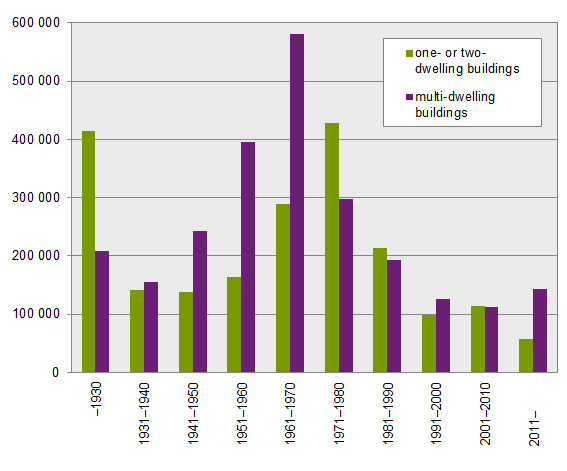Dwelling stock 2017-12-31:
Over 4.8 million dwellings in Sweden
Statistical news from Statistics Sweden 2018-04-19 9.30
On 2017-12-31, there were 4 859 252 dwellings. Among these, 2 069 353 dwellings (43 percent) were in one- or two-dwelling buildings, 2 462 972 (51 percent) were in multi-dwelling buildings, 247 277 (5 percent) were in special housing and 79 650 (2 percent) were in other buildings.
Rented dwellings most common type of tenure in multi-dwelling buildings
In multi-dwelling buildings, rented dwellings are the most common type of tenure, 59 percent of the total dwelling stock, while 41 percent consist of tenant-owned dwellings. Among the 10 largest municipalities, rented dwellings dominated in seven of them, while only two municipalities – Uppsala and Stockholm – had more tenant-owned dwellings than rented dwellings. In Västerås municipality, the proportion is 50 percent respectively, that is, there was an equal number of rented dwellings and tenant-owned dwellings.
| Municipalty | Share of rental units | Share of tenant- owned units |
|---|---|---|
|
Örebro
|
78 | 22 |
|
Norrköping
|
68 | 32 |
|
Linköping
|
68 | 32 |
|
Jönköping
|
65 | 35 |
|
Helsingborg
|
64 | 36 |
|
Göteborg
|
63 | 37 |
|
Malmö
|
52 | 48 |
|
Västerås
|
50 | 50 |
|
Stockholm
|
44 | 56 |
|
Uppsala
|
36 | 64 |
The division of rented dwellings and tenant-owned dwellings refers to multi-dwelling buildings.
Private ownership is the most common type of tenure in one- or two-dwelling buildings, at 91 percent. The proportion of rented dwellings and tenant-owned dwellings in one- or two-dwelling buildings is 5 and 4 percent respectively.
Housing cooperatives most common owners of multi-dwelling buildings
With regard to dwellings in multi-dwelling buildings, about 41 percent are owned by housing cooperatives, 28 percent are owned by municipal housing companies and 21 percent are owned by Swedish joint-stock companies. The remaining 10 percent are owned by other legal persons and private persons.
With regard to one- or two-dwelling buildings, the vast majority (91 percent) are owned by private persons and only four percent are owned by housing cooperatives.
Dwellings’ size and age
The average dwelling in multi-dwelling buildings is 2 rooms and kitchen, with an average size of 60 square metres. The average size of the one- or two-dwelling building is 122 square metres.
| Size of dwelling | Number of dwellings | Share in percentage |
|---|---|---|
|
Dwellings without kitchen
|
1 692 | 0.1 |
|
1 room and kitchen
|
280 392 | 11.4 |
|
1 room and kitchenette
|
115 050 | 4.7 |
|
2 rooms and kitchen
|
894 919 | 36.3 |
|
2 or more rooms with kitchenette
|
45 826 | 1.9 |
|
3 rooms and kitchen
|
775 783 | 31.5 |
|
4 rooms and kitchen
|
272 027 | 11 |
|
5 rooms and kitchen
|
54 328 | 2.2 |
|
6 or more rooms and kitchen
|
11 066 | 0.4 |
|
Data missing
|
11 889 | 0.5 |
|
Summa
|
2 462 972 | 100 |
Nearly 931 000 (45 percent) of one- or two-dwelling buildings were built between 1961 and 1990. However, one in five houses (or 20 percent) among one- or two-dwelling buildings was built as early as before 1931. With regard to multi-dwelling buildings, most of them (52 percent) were built between 1951 and 1980.

Special housing
There are 247 277 dwellings in special housing in total divided into 132 923 special housing for the elderly/disabled, 96 990 dwellings for students and 17 364 other special housing. The average size of an apartment in a retirement home is 39 square metres, while the average size of a student apartment is 28 square metres. Most student housing can be found, not surprisingly, in the major university towns.
Municipality |
Number of dwellings |
|---|---|
Uppsala |
11 261 |
Göteborg |
10 546 |
Stockholm |
9 872 |
Lund |
9 099 |
Umeå |
6 121 |
Linköping |
5 039 |
Växjö |
3 680 |
Örebro |
3 544 |
Definitions and explanations
The statistics are based on the dwelling register, which is a national register of all Swedish dwellings. The register is managed by Lantmäteriet, which is also the responsible authority. Statistics Sweden receives data from Lantmäteriet in order to produce current household and housing statistics.
One- or two-dwelling buildings refer to detached one- and two-dwelling buildings as well as semi-detached, row and linked buildings.
Multi-dwelling buildings refer to buildings with three or more apartments, including balcony access housing.
Other buildings refers to buildings that are not intended for residential purposes, but that nonetheless contain regular apartments, for example, buildings intended for business or public activities.
Special housing refers to dwellings for the elderly/disabled, student housing and other special housing.
The type of tenure of the apartments is based on ownership, not residents’ use of the apartments.
Feel free to use the facts from this statistical news but remember to state Source: Statistics Sweden.
